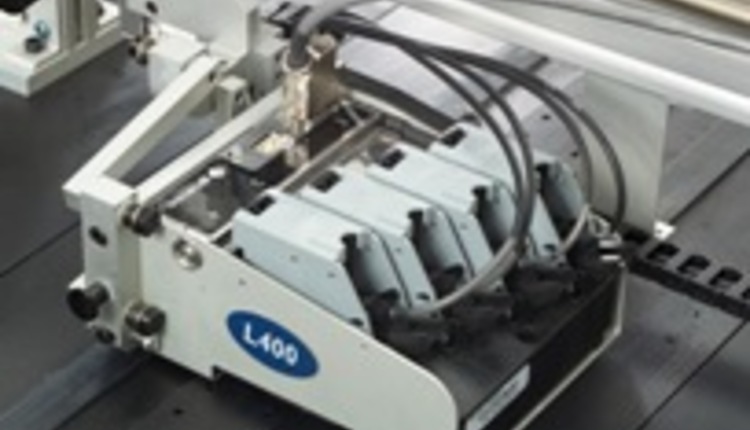Mailing Systems Technology asked some of the top inkjet addressing companies: What are the latest developments in addressing systems and what should mail center managers take into account when considering addressing systems?
Ken Stack, president, Jetrion LLC
As large and small mailers consider their futures, more and more are realizing that the inkjet technology they embrace today will have a significant impact on their abilities to compete tomorrow. For addressing at high speeds on a range of substrates at high quality, mailers are turning away from continuous inkjet and embracing drop-on-demand (DOD) inkjet.
Let's take a look at the reasons behind this technology shift. First, mailers now understand that profitability comes from turning jobs over as fast as possible. The cost of downtime caused by an inkjet printer is greater than lost labor and equipment rates; it's lost opportunity. With DOD inkjet, starting up a job doesn't have to be an hour-long ordeal. Because these drop-on-demand inkjet printers don't require ink recirculation, don't charge the ink during the printing process and have no moving parts, DOD startups tend to be job-ready sooner than continuous inkjet.
Second, mailers are being asked to print on substrates that aren't the traditional, absorbent matte envelopes. Sometimes mailer needs to print on a clear poly window, a poly-bag or on a gloss paper. Continuous inkjet systems have traditionally used water-based inks, which are effective on absorbent substrates, but are mostly ineffective on non-absorbent surfaces. On the other hand, DOD offers UV- and solvent-based inks that dry faster and adhere to a broader range of surfaces.
In the last decade, two DOD printing technologies have made significant inroads to the mail market, both from an ink and printhead standpoint. These are thermal inkjet (TIJ) and piezoelectric inkjet (PIJ). It's no secret that HP-based TIJ printers have taken significant market share. The swapping of cartridges places HP systems in the "easy-to-use" category.
So what does the future hold for TIJ? Mailers have been from HP print. Now, companies are preparing to bring to market new TIJ inks that are no longer purely water-based and coatings that will shorten dry times and improve adhesion. TIJ technology developments have been fast and furious in recent years. Today, reliability is almost an afterthought. The future in mail is being written today, and DOD inkjet is positioned to lead.
Ron Gilboa, vice president, Marketing, Kodak Versamark
These are challenging and exciting times for mailing and fulfillment operations. With seemingly constant change in postal services as well as new legislation on telemarketing and email (SPAM), print providers have to continually monitor their operations to respond to increasing market requirements. For example, mailing and fulfillment companies are now facing increased scrutiny from the post office to ensure that barcodes are machine readable. And, with the advent of the post office's MERLIN barcode verification system, many mailers are not being credited with their barcode automation discounts.
In this environment, savvy commercial printers view change as opportunity and as potential sources of new income for their operations. Today, these providers have a wide selection of technology and especially inkjet technology to enable their businesses to maintain a competitive edge.
Three types of inkjet systems dominate the mailing and fulfillment markets: continuous inkjet (CIJ), piezoelectric drop-on-demand (DOD) and thermal (cartridge-based) DOD. For high-volume, high-throughput mailing operations, continuous inkjet provides clear advantages with its extremely low operating cost and extremely high speed and throughput. Continuous inkjet is also flexible and easy to integrate into other processes.
Print providers must also consider other factors when evaluating various inkjet mailing systems, including substrates requirements, capital acquisition costs, print quality, upgradeability and reliability. Different types of technology may be more appropriate for certain applications and piece-volume levels.
Typically, high-volume mailers tend to use continuous inkjet, due to its extremely high speed/throughput, good reliability and extremely low-cost of operation. The capital acquisition cost of continuous inkjet tends to be more than thermal DOD, but running costs of CIJ are typically a fraction of that of thermal DOD.
Substrate range is also a crucial factor. For porous paper substrates, including most envelopes and many direct mail pieces, water-based inks are a great choice due to their relative ease of running through inkjet printers and their relatively low cost. However, more and more direct mail pieces are utilizing coated papers and even in some instances plastic cards and other difficult to print on surfaces. For these applications, one may need to turn to a solvent or UV-curable ink. Both CIJ and DOD printers offer solvent ink, and DOD printers offer UV-curable inks.
A last consideration is in vendor selection. Commercial printers must be confident that the supplier understands and is committed to the industry. Providers like Kodak Versamark, recognized as a world leader in continuous inkjet technology, should offer a wide range of printing solutions that not only meet current business requirements, but more importantly, grow as printing requirements change. By selecting a vendor who understands the challenges of the mailing and fulfillment industry, commercial printers can be confident of maintaining a competitive position.
Robert V. Weaver, president and CEO, PRISM Incorporated
Technology that provides the ability to control all functions and integrate multiple inkjet technologies on a single line is of the utmost importance and should be the driving force in the decision of mail center managers considering high-end mail creation systems.
The changing climate in mail production due to the restrictions placed on marketers with regard to outbound telemarketing, means that companies must return to a heavier mix of direct to customer/prospect communication via traditional mail with non-traditional mailpieces. What this means to the mail producer is that they must do more with different materials, in different ways, in less time, under tighter constraints. Mail managers should require what I have demanded from our systems, and that is the ability to integrate multiple production processes with a high-quality, reliable system they can leverage to fully accommodate their customers' changing needs.
You can find a basic addressing system to put down ink on an envelope and meet the needs of a small lettershop. But what is the organization to do if it needs to perform complex operations with multiple levels of variable data, inserting, piece tracking, duplexing, downstream controls, vision system verification, reporting, sort or zone breaks as well as control of multiple pieces of equipment and even other inkjet technology? That organization needs a vendor and integrator that can orchestrate the complex process.
What a mail center manager needs to look for in a high-end system is flexibility, versatility and power. The flexibility to fit the needs of the company's application today, the versatility to be able to meet the growing or changing needs of an organization in the future and the power to control the entire process.
In addition to the actual hardware and software of a system, customers need to have the security and support of a vendor that stands beside its products and is available 24/7 to support them on their schedules. Mail production is not just a nine to five prospect, Monday through Friday. In the event the system has an issue on Saturday night at the start of a million piece run that must be completed by Wednesday, your vendor better be available to support you.
Charles A. Rothofsky, Marketing Communications Manager, Secap
Print-to-mail operations and variable data printing are driving a tremendous amount of change in high-end addressing. Addressing technologies are being integrated into presses, binderies and other printing equipment to enable the dynamic personalization of printed materials. Marketing departments and companies with incredible amounts of customer data are driving the increase of customized communications on high gloss materials, perpetuating the need for high-end variable data solutions. These technologies can be implemented either in-line or near-line for increasing productivity and maximizing efficiencies within the printing environment. Technology and ink choices are available when considering these variable data solutions. Ink choices such as solvent-based and UV-curable have been leading the way in today's high-end addressing systems. Some solvent-based inks can now dry unassisted on glossy and aqueous coated media in a very short time. On the other hand, UV curable inks have become increasingly popular due in part to the wide range of substrates that need to be personalized. UV curable is very durable and can be cured on a wide range of substrates including aqueous, plastic and even metal at high production rates, allowing for the delivery of personalized communications on virtually any medium desired.
Marketing has driven the evolution of high-end addressing systems to become more integrated with printing operations. Mail center managers must consider many factors when considering the addition of addressing systems. Performing an internal assessment of the media types and sizes and the largest and average job size will be crucial to selecting an appropriate system. Determining the current and future applications that will be offered will also need careful consideration. Understanding whether to integrate the variable data printing in-line or to operate near line will also need evaluation. Integration can pose many challenges and reveal many opportunities. Personnel will need to be selected for training and operation of the equipment. Some systems can require specialized operator training. Implementing a maintenance program or training internal employees for maintaining equipment will also need to be considered. There are wide ranges of factors to consider when reviewing the addition of high-end addressing systems. When it comes to adding mailing services, careful, up-front planning can deliver extraordinary results.


